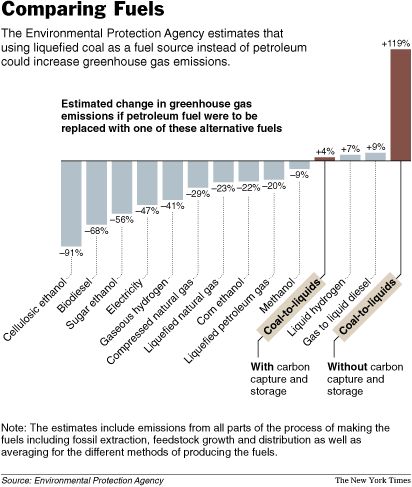Those of you with strong stomachs will want to marvel at the contrast between two New York Times stories out today. Marvel … and tear your fracking hair out.
First, there’s this story on energy efficiency. It makes the simple and familiar point that the cheapest, fastest source of energy is negawatts — not using the energy in the first place. In particular, efficiency is cheaper than coal:
“When we started talking about this in 1990s in terms of energy efficiency versus coal energy, we were talking 4 cents a kilowatt-hour for coal, and 4 cents for energy efficiency,” said R. Neal Elliott, the industrial program director at the [American Council for an Energy Efficient Economy]. “Today we’re talking optimistically, without carbon taxes, 10 cents for coal. With carbon taxes, we may be talking 20 cents for coal.”
“And energy efficiency,” he said, “is still 4 cents or less.”
Despite this widely acknowledged fact, efforts to get at those efficiency savings are scarce and fitful. Vermont has a good program; Gov. Spitzer in New York promised one. But by and large, little attention is being paid to this low-hanging fruit, particularly not by the feds.
In sharp contrast, check out this story on the push for liquefied coal.
As I’ve said many times, the best case scenario for coal-to-liquids (CTL) is that every CTL plant is adjoined by an expensive (and as yet technologically unproven) carbon sequestration facility. Given that best case scenario, CTL will be neutral toward carbon emissions. This fantastic infographic from the NYT tells the story:
Copyright 2007 The New York Times Company
So CTL will do basically nothing for global warming, except possibly exacerbate it. What about the vaunted "energy independence" benefits? Well, not at this price:
[A team at MIT] estimated that it would cost $70 billion to build enough plants to replace 10 percent of American gasoline consumption.
The study estimates that the construction costs for coal-to-liquid plants are almost four times higher than the costs for comparable petroleum refineries, and it argues that cost estimates for synthetic fuel plants in the past turned out to be “wildly optimistic.”
In a new report last week, the Energy Department estimated that a plant capable of making 50,000 barrels of liquefied coal a day — a tiny fraction of the nearly 9 million barrels in gasoline burned daily in the United States — would cost $4.5 billion.
So: an enormous expense, for miniscule energy security benefits and no carbon reductions. Sounds great, eh?
It sounds great to policymakers, though:
… the scale of proposed subsidies for coal could exceed those for any alternative fuel, including corn-based ethanol.
Among the proposed inducements winding through House and Senate committees: loan guarantees for six to 10 major coal-to-liquid plants, each likely to cost at least $3 billion; a tax credit of 51 cents for every gallon of coal-based fuel sold through 2020; automatic subsidies if oil prices drop below $40 a barrel; and permission for the Air Force to sign 25-year contracts for almost a billion gallons a year of coal-based jet fuel.
Why on earth would Congress do something so criminally stupid, so manifestly against the public interest? Why do they ever?
Coal industry lobbying has reached a fever pitch. The industry spent $6 million on federal lobbying in 2005 and 2006, three times what it spent each year from 2000 through 2004, according to calculations by Politicalmoneyline.com.
There’s your civics lesson from today’s NYT, kids:
- Energy efficiency: a financial boon and a cheap, fast way to reduce carbon emissions. But: no big industry lobby. Thus: ignored by the feds.
- CTL: a financial boondoggle with few energy security benefits that will aggravate climate change. But: big industry lobby. Thus: plied with billions in taxpayer subsidies.
Looking for something to chat about with your Congressional representative? This seems like a good place to start.



